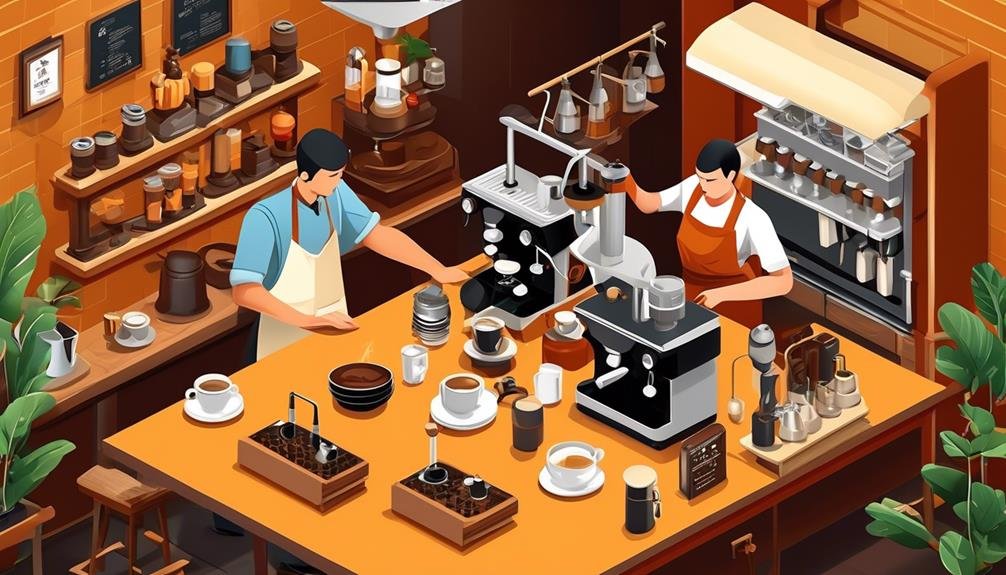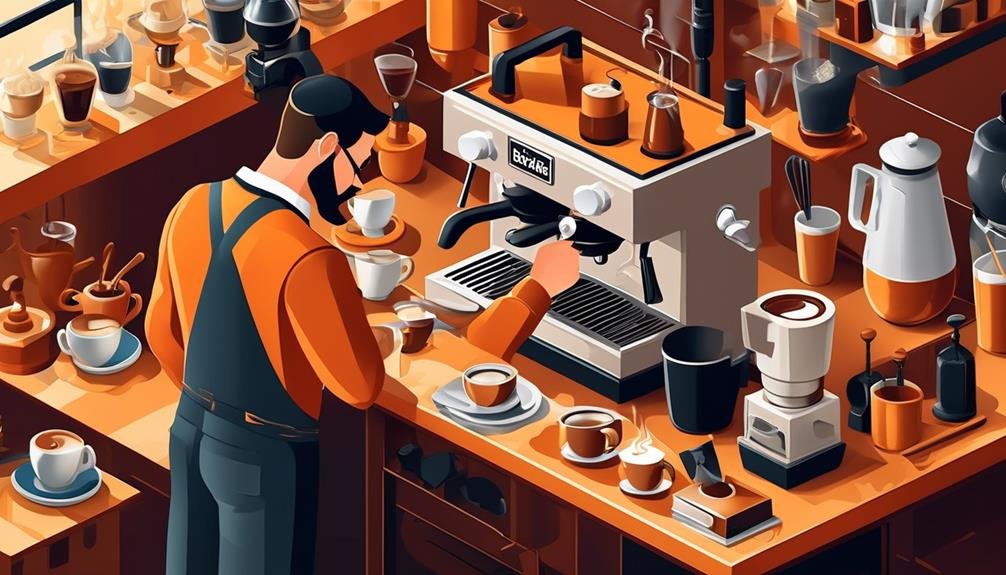Are you tired of that bitter, unpleasant taste in your espresso shot? Well, fear not, because there's a way to troubleshoot and fix the problem.
Whether you're a seasoned barista or a coffee enthusiast, understanding the factors that contribute to a bad tasting espresso shot is crucial. From the quality of the portafilter basket to the grind size and dose, there are various elements that can impact the taste of your brew.
So, if you're ready to uncover the secrets to a perfect espresso, keep reading to discover the steps you need to take to troubleshoot and resolve any issues.
Key Takeaways
- Observation of the appearance and taste of the shot is crucial in troubleshooting bad tasting espresso shots.
- Adjusting the grind size can help correct extraction issues and improve the overall taste of the shot.
- Fine-tuning the wet and dry doses can adjust the concentration, strength, and flavor of the shot.
- Seeking professional help from experienced technicians is necessary for complex issues with the espresso machine and to ensure the best possible espresso experience.
Identify the Problem
To troubleshoot a bad tasting espresso shot, you need to first identify the problem. This can be done by carefully observing the appearance and taste of the shot, noting any signs of over-extraction or under-extraction. Over-extraction occurs when too much water is forced through the coffee grounds, resulting in a bitter and harsh taste. Under-extraction, on the other hand, happens when insufficient water is used, leading to a weak and sour flavor.
When examining the shot, pay attention to its color and volume. A properly extracted espresso should have a rich, dark brown color with a thick, creamy layer of crema on top. If the shot appears too light or too dark, it could be an indication of extraction issues.
In addition to visual cues, it's important to taste the espresso. Take note of any off-flavors or imbalances in taste. A well-extracted shot should have a balanced flavor profile, with a combination of sweetness, acidity, and bitterness. If any of these elements are overpowering or lacking, it could point to a problem with the extraction process.
Adjust Grind Size
Adjusting the grind size is a crucial step in troubleshooting a bad tasting espresso shot. The grind size significantly impacts the extraction and strength of your espresso shots. To ensure you're getting the best-tasting espresso, make sure to adjust the grind size accordingly.
Here are some tips to help you adjust the grind size effectively:
- Coarsen the grind if the shot is over-extracted or pulls too slowly. By coarsening the grind, you allow water to flow more easily through the coffee grounds, reducing extraction and preventing the shot from becoming bitter.
- Fine the grind if the shot is under-extracted or pulls too fast. Fining the grind increases water-coffee contact time, allowing for better extraction and a more balanced flavor profile.
- Keep in mind that small adjustments in grind size can have a significant impact on the taste of your espresso. Start with small increments and observe the changes in the shot.
- Remember to adjust the grind size gradually. Making drastic changes can lead to inconsistent and unpredictable results.
- Regularly calibrate your grinder to ensure consistent grind size. This will help you maintain the desired extraction and taste of your espresso shots.
Fine-tune Wet Dose

For optimal extraction and concentration in your espresso shot, fine-tuning the wet dose is essential. The wet dose refers to the amount of water used in the extraction process. Using a gram scale to measure the wet dose ensures consistency and allows you to make adjustments as needed.
If your shot is too concentrated or under-extracted, increasing the wet dose can help allow for more extraction, resulting in a better-tasting shot. On the other hand, if your shot is weak or over-extracted, decreasing the wet dose will reduce extraction and increase concentration, improving the flavor profile.
It's important to experiment with different wet doses to find the appropriate yield for the desired espresso flavor. Keep in mind that the wet dose is just one of the variables that affect the taste of your espresso. Other factors such as grind size, shot time, and group head temperature also play a role.
Fine-tune Dry Dose
Fine-tuning the dry dose of your espresso is crucial for achieving the desired strength and flavor in your shot. Here are some tips to help you fine-tune your dry dose:
- Experiment with different dry doses to find the optimal amount for your portafilter basket. Every espresso machine and coffee grind is different, so it may take some trial and error to find the perfect dose.
- Adjust the dry dose based on the desired strength and flavor of the espresso shot. If you prefer a stronger and more concentrated shot, increase the dose. For a milder and less concentrated shot, decrease the dose.
- Use a gram scale to ensure consistency when measuring the dry dose. This will help you maintain the same dose each time you make espresso, resulting in a more consistent flavor.
- Increasing the dry dose can lead to a stronger and more concentrated espresso shot. This can be ideal for those who enjoy a bold and intense flavor.
- On the other hand, decreasing the dry dose can result in a milder and less concentrated espresso shot. This may be preferable for those who prefer a lighter and smoother taste.
Clean and Maintain Equipment

Regularly cleaning and maintaining your espresso machine and equipment is essential for preventing unpleasant taste and functionality issues. To ensure great espresso, it's crucial to keep your equipment clean and in proper working condition.
Start by regularly cleaning the espresso machine, removing any built-up residue or oils that can affect the flavor of your coffee. This includes cleaning the group head, portafilter, and steam wand. Additionally, make sure to clean and descale the water reservoir and replace any worn-out parts as needed.
Along with cleaning, it's important to maintain the equipment. Calibrate your tamp or practice consistent tamping pressure to ensure even extraction and prevent channeling. Monitor the grinder settings and make regular adjustments to maintain optimal results. Consider investing in a computerized thermostat or PID controller for temperature control, as brewing at the ideal temperature is crucial for a great espresso.
Lastly, use high-quality coffee beans and ensure consistency in roasting, as inconsistent beans and roasting can affect the flavor and consistency of the espresso. By regularly cleaning and maintaining your equipment, you can ensure that your espresso shots are consistently delicious.
Experiment With Different Coffee Beans
To further enhance the taste of your espresso shots, it's time to explore the world of different coffee beans. By experimenting with different beans, you can unlock new flavors and aromas that will make your espresso shots truly exceptional.
Here are some tips to help you make great espresso by choosing the right coffee beans:
- Try different roasts and origins: By exploring a variety of roasts and origins, you can discover a wide range of flavors and aromas in your espresso shots. From light and fruity to dark and chocolatey, each roast and origin offers a unique taste experience.
- Experiment with single-origin beans versus blends: Single-origin beans allow you to taste the specific characteristics of a particular region, while blends offer a balance of flavors from different origins. Try both to understand how different coffee beans impact the taste of your espresso.
- Consider specialty coffee beans: Specialty coffee beans, with their unique processing methods, can provide new and distinct flavor profiles. Look for beans with specific processing techniques, such as honey or natural, to add complexity to your espresso shots.
- Adjust your brewing parameters: When using different coffee beans, it's important to adjust your brewing parameters, such as grind size and extraction time. This will help optimize the flavor extraction and ensure the best possible taste.
- Keep a tasting journal: Keeping a tasting journal allows you to note the characteristics of each coffee bean used. This will help you track and compare the results of your espresso experiments, enabling you to refine your brewing techniques and find your perfect cup.
Seek Professional Help if Needed

If troubleshooting fails to resolve the issue, it's advisable to seek professional help from a technician for a more detailed assessment of your espresso machine. While you may be able to fix some problems on your own, there are instances where the expertise of a professional is necessary to ensure that your espresso machine is in great working condition.
When it comes to espresso machines, there are many intricate components that need to be properly maintained and calibrated. If your espresso shots are consistently coming out overly bitter or have an off taste, it could be a sign of a more serious problem. A professional technician will have the knowledge and experience to diagnose and fix any issues that may be affecting the taste of your espresso.
Keep in mind that seeking professional help isn't a sign of failure, but rather a proactive step towards achieving the best possible espresso experience. Companies like Crema offer guidance and support, and can connect you with trusted technicians who specialize in espresso machine repairs.
Additionally, joining organizations like the Specialty Coffee Association of America (SCAA) and attending their conventions and competitions can provide opportunities to learn more about espresso equipment and connect with coffee professionals who can offer insights on tasting and identifying good espresso.
Frequently Asked Questions
Why Does My Espresso Shot Taste Bad?
Your espresso shot may taste bad due to factors such as using old or improperly roasted coffee, grinding too coarse, brewing at the wrong temperature, or using dirty equipment.
How Do You Fix Bad Espresso?
To fix bad espresso, diagnose the issue by evaluating extraction time, color, and volume. Adjust the grind size and wet and dry dose accordingly. Consider factors like coffee beans, roast date, and water temperature. Experiment with brewing techniques to enhance flavor.
How Do You Troubleshoot an Espresso Shot?
To troubleshoot a bad tasting espresso shot, start by considering factors like portafilter baskets, coffee strength and crema, shot channelling, sourness, and bitterness. Experiment, adjust, and seek professional help if needed.
How Do You Make Espresso Shots Taste Better?
To make espresso shots taste better, start by using freshly roasted beans and grinding them to the right consistency. Ensure the water temperature is between 195-205°F and the extraction time is around 25-30 seconds. Adjust these factors until you find the perfect balance.
Conclusion
In conclusion, troubleshooting a bad tasting espresso shot requires careful consideration of various factors. These factors include the portafilter basket, dose, grind size, and equipment maintenance.
By identifying the problem, adjusting the grind size, and fine-tuning the wet and dry dose, you can improve the taste of your espresso. Additionally, experimenting with different coffee beans can also help enhance the flavor.
Regular cleaning and maintenance of the equipment are also essential in ensuring a good-tasting espresso shot. This includes keeping the grinder clean and properly calibrated, as well as descaling the espresso machine regularly.
However, it's important to note that in some cases, seeking professional help may be necessary for more complex issues that cannot be resolved through simple troubleshooting.




